Early Church Meetings: Analyzing Structure and Purpose in Corinthians
VerifiedAdded on 2023/01/13
|7
|1952
|61
Essay
AI Summary
This essay delves into the structure and purpose of early church meetings as revealed in Paul's letters to the Corinthians. It examines the social and religious context of Corinth, highlighting issues such as social divisions, tensions between different groups within the church, and the challenges faced by early Christians. The essay explores the guidelines for church meetings, the role of the Holy Spirit, and the importance of community. It analyzes Paul's instructions on various matters, including the treatment of outsiders, the role of women, and the consumption of food offered to idols. The essay underscores how Paul's letters provide insights into the early church's practices and the development of Christian doctrine, revealing the challenges and triumphs of early Christian communities in establishing their faith.
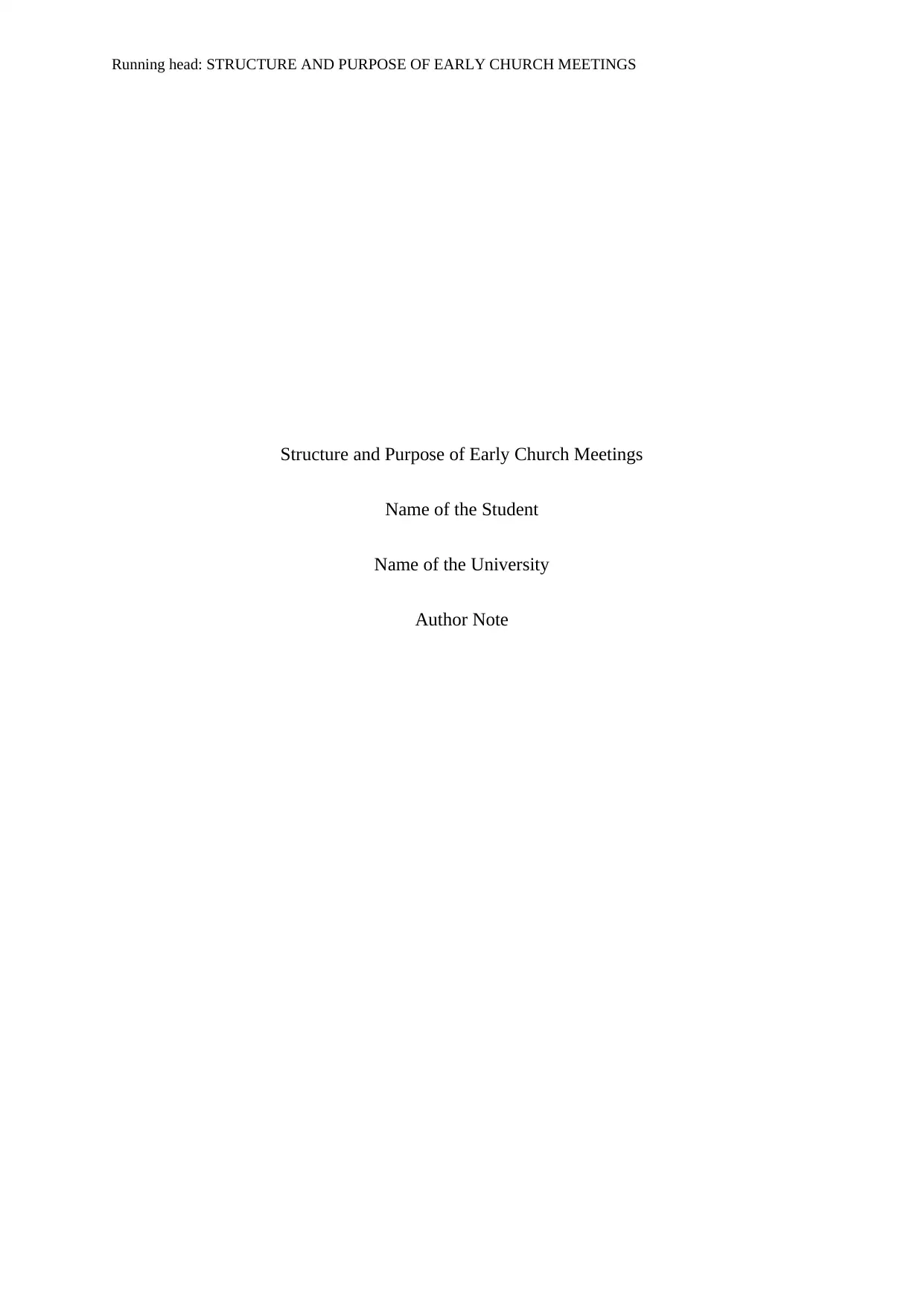
Running head: STRUCTURE AND PURPOSE OF EARLY CHURCH MEETINGS
Structure and Purpose of Early Church Meetings
Name of the Student
Name of the University
Author Note
Structure and Purpose of Early Church Meetings
Name of the Student
Name of the University
Author Note
Paraphrase This Document
Need a fresh take? Get an instant paraphrase of this document with our AI Paraphraser
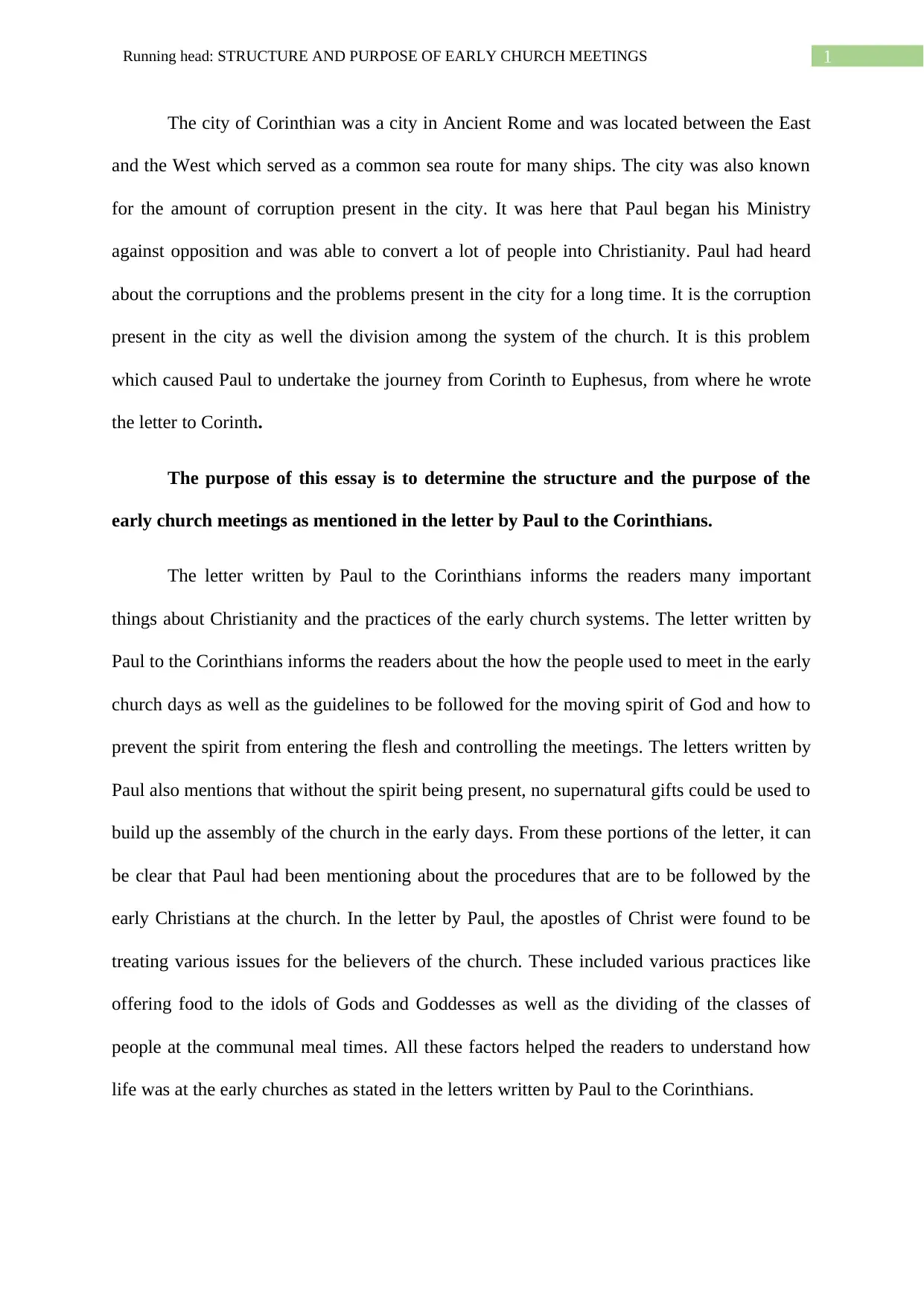
1Running head: STRUCTURE AND PURPOSE OF EARLY CHURCH MEETINGS
The city of Corinthian was a city in Ancient Rome and was located between the East
and the West which served as a common sea route for many ships. The city was also known
for the amount of corruption present in the city. It was here that Paul began his Ministry
against opposition and was able to convert a lot of people into Christianity. Paul had heard
about the corruptions and the problems present in the city for a long time. It is the corruption
present in the city as well the division among the system of the church. It is this problem
which caused Paul to undertake the journey from Corinth to Euphesus, from where he wrote
the letter to Corinth.
The purpose of this essay is to determine the structure and the purpose of the
early church meetings as mentioned in the letter by Paul to the Corinthians.
The letter written by Paul to the Corinthians informs the readers many important
things about Christianity and the practices of the early church systems. The letter written by
Paul to the Corinthians informs the readers about the how the people used to meet in the early
church days as well as the guidelines to be followed for the moving spirit of God and how to
prevent the spirit from entering the flesh and controlling the meetings. The letters written by
Paul also mentions that without the spirit being present, no supernatural gifts could be used to
build up the assembly of the church in the early days. From these portions of the letter, it can
be clear that Paul had been mentioning about the procedures that are to be followed by the
early Christians at the church. In the letter by Paul, the apostles of Christ were found to be
treating various issues for the believers of the church. These included various practices like
offering food to the idols of Gods and Goddesses as well as the dividing of the classes of
people at the communal meal times. All these factors helped the readers to understand how
life was at the early churches as stated in the letters written by Paul to the Corinthians.
The city of Corinthian was a city in Ancient Rome and was located between the East
and the West which served as a common sea route for many ships. The city was also known
for the amount of corruption present in the city. It was here that Paul began his Ministry
against opposition and was able to convert a lot of people into Christianity. Paul had heard
about the corruptions and the problems present in the city for a long time. It is the corruption
present in the city as well the division among the system of the church. It is this problem
which caused Paul to undertake the journey from Corinth to Euphesus, from where he wrote
the letter to Corinth.
The purpose of this essay is to determine the structure and the purpose of the
early church meetings as mentioned in the letter by Paul to the Corinthians.
The letter written by Paul to the Corinthians informs the readers many important
things about Christianity and the practices of the early church systems. The letter written by
Paul to the Corinthians informs the readers about the how the people used to meet in the early
church days as well as the guidelines to be followed for the moving spirit of God and how to
prevent the spirit from entering the flesh and controlling the meetings. The letters written by
Paul also mentions that without the spirit being present, no supernatural gifts could be used to
build up the assembly of the church in the early days. From these portions of the letter, it can
be clear that Paul had been mentioning about the procedures that are to be followed by the
early Christians at the church. In the letter by Paul, the apostles of Christ were found to be
treating various issues for the believers of the church. These included various practices like
offering food to the idols of Gods and Goddesses as well as the dividing of the classes of
people at the communal meal times. All these factors helped the readers to understand how
life was at the early churches as stated in the letters written by Paul to the Corinthians.
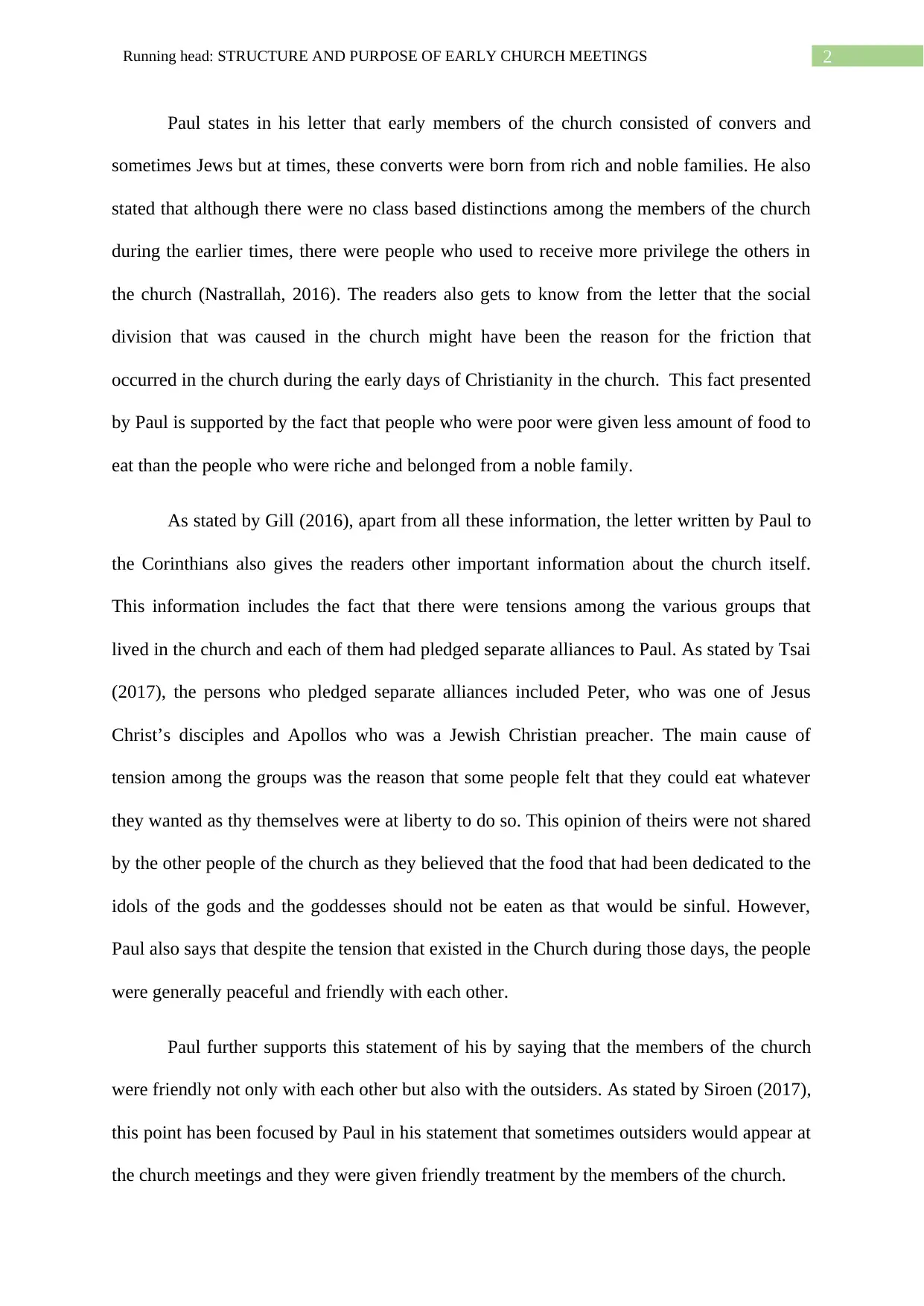
2Running head: STRUCTURE AND PURPOSE OF EARLY CHURCH MEETINGS
Paul states in his letter that early members of the church consisted of convers and
sometimes Jews but at times, these converts were born from rich and noble families. He also
stated that although there were no class based distinctions among the members of the church
during the earlier times, there were people who used to receive more privilege the others in
the church (Nastrallah, 2016). The readers also gets to know from the letter that the social
division that was caused in the church might have been the reason for the friction that
occurred in the church during the early days of Christianity in the church. This fact presented
by Paul is supported by the fact that people who were poor were given less amount of food to
eat than the people who were riche and belonged from a noble family.
As stated by Gill (2016), apart from all these information, the letter written by Paul to
the Corinthians also gives the readers other important information about the church itself.
This information includes the fact that there were tensions among the various groups that
lived in the church and each of them had pledged separate alliances to Paul. As stated by Tsai
(2017), the persons who pledged separate alliances included Peter, who was one of Jesus
Christ’s disciples and Apollos who was a Jewish Christian preacher. The main cause of
tension among the groups was the reason that some people felt that they could eat whatever
they wanted as thy themselves were at liberty to do so. This opinion of theirs were not shared
by the other people of the church as they believed that the food that had been dedicated to the
idols of the gods and the goddesses should not be eaten as that would be sinful. However,
Paul also says that despite the tension that existed in the Church during those days, the people
were generally peaceful and friendly with each other.
Paul further supports this statement of his by saying that the members of the church
were friendly not only with each other but also with the outsiders. As stated by Siroen (2017),
this point has been focused by Paul in his statement that sometimes outsiders would appear at
the church meetings and they were given friendly treatment by the members of the church.
Paul states in his letter that early members of the church consisted of convers and
sometimes Jews but at times, these converts were born from rich and noble families. He also
stated that although there were no class based distinctions among the members of the church
during the earlier times, there were people who used to receive more privilege the others in
the church (Nastrallah, 2016). The readers also gets to know from the letter that the social
division that was caused in the church might have been the reason for the friction that
occurred in the church during the early days of Christianity in the church. This fact presented
by Paul is supported by the fact that people who were poor were given less amount of food to
eat than the people who were riche and belonged from a noble family.
As stated by Gill (2016), apart from all these information, the letter written by Paul to
the Corinthians also gives the readers other important information about the church itself.
This information includes the fact that there were tensions among the various groups that
lived in the church and each of them had pledged separate alliances to Paul. As stated by Tsai
(2017), the persons who pledged separate alliances included Peter, who was one of Jesus
Christ’s disciples and Apollos who was a Jewish Christian preacher. The main cause of
tension among the groups was the reason that some people felt that they could eat whatever
they wanted as thy themselves were at liberty to do so. This opinion of theirs were not shared
by the other people of the church as they believed that the food that had been dedicated to the
idols of the gods and the goddesses should not be eaten as that would be sinful. However,
Paul also says that despite the tension that existed in the Church during those days, the people
were generally peaceful and friendly with each other.
Paul further supports this statement of his by saying that the members of the church
were friendly not only with each other but also with the outsiders. As stated by Siroen (2017),
this point has been focused by Paul in his statement that sometimes outsiders would appear at
the church meetings and they were given friendly treatment by the members of the church.
⊘ This is a preview!⊘
Do you want full access?
Subscribe today to unlock all pages.

Trusted by 1+ million students worldwide
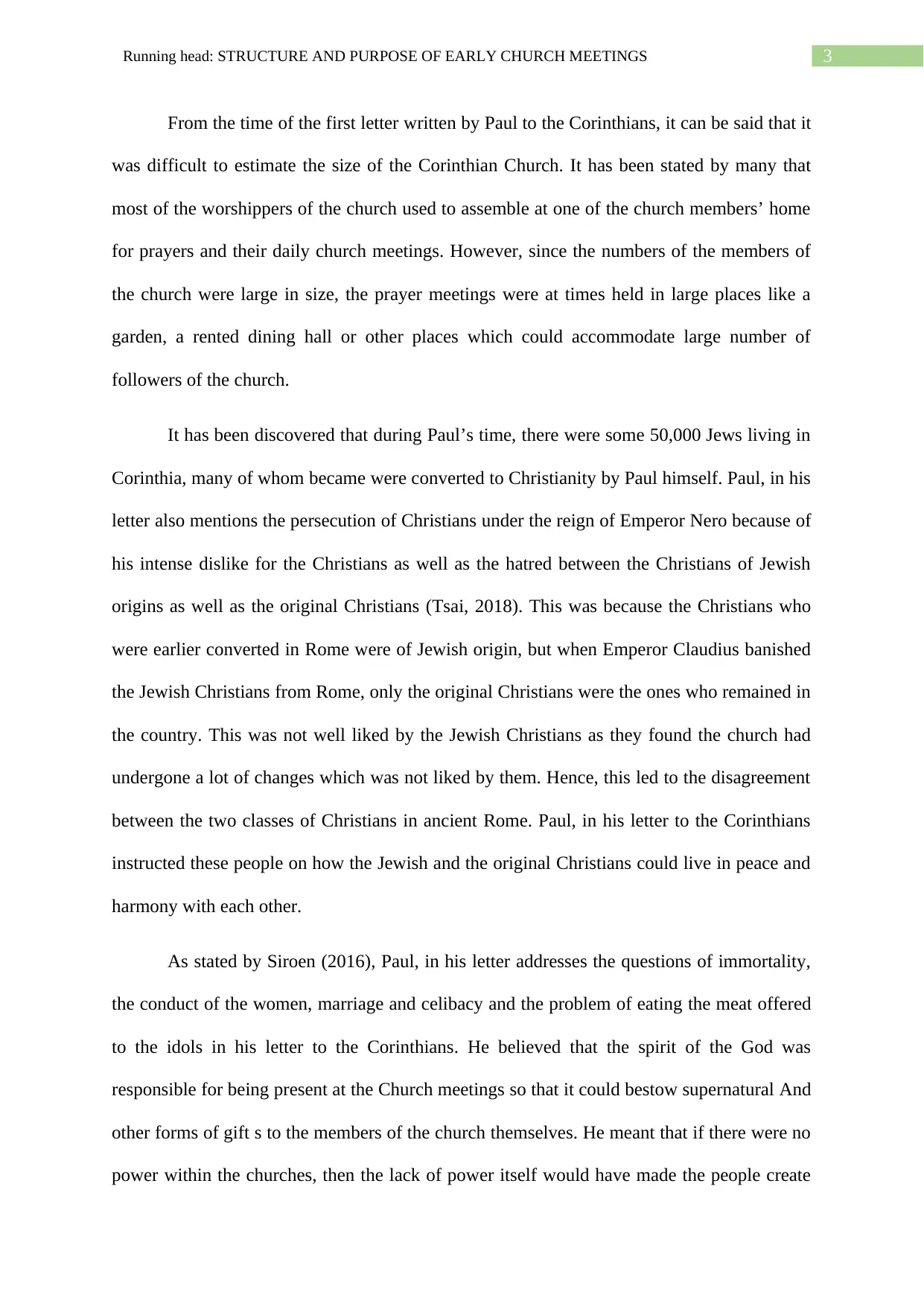
3Running head: STRUCTURE AND PURPOSE OF EARLY CHURCH MEETINGS
From the time of the first letter written by Paul to the Corinthians, it can be said that it
was difficult to estimate the size of the Corinthian Church. It has been stated by many that
most of the worshippers of the church used to assemble at one of the church members’ home
for prayers and their daily church meetings. However, since the numbers of the members of
the church were large in size, the prayer meetings were at times held in large places like a
garden, a rented dining hall or other places which could accommodate large number of
followers of the church.
It has been discovered that during Paul’s time, there were some 50,000 Jews living in
Corinthia, many of whom became were converted to Christianity by Paul himself. Paul, in his
letter also mentions the persecution of Christians under the reign of Emperor Nero because of
his intense dislike for the Christians as well as the hatred between the Christians of Jewish
origins as well as the original Christians (Tsai, 2018). This was because the Christians who
were earlier converted in Rome were of Jewish origin, but when Emperor Claudius banished
the Jewish Christians from Rome, only the original Christians were the ones who remained in
the country. This was not well liked by the Jewish Christians as they found the church had
undergone a lot of changes which was not liked by them. Hence, this led to the disagreement
between the two classes of Christians in ancient Rome. Paul, in his letter to the Corinthians
instructed these people on how the Jewish and the original Christians could live in peace and
harmony with each other.
As stated by Siroen (2016), Paul, in his letter addresses the questions of immortality,
the conduct of the women, marriage and celibacy and the problem of eating the meat offered
to the idols in his letter to the Corinthians. He believed that the spirit of the God was
responsible for being present at the Church meetings so that it could bestow supernatural And
other forms of gift s to the members of the church themselves. He meant that if there were no
power within the churches, then the lack of power itself would have made the people create
From the time of the first letter written by Paul to the Corinthians, it can be said that it
was difficult to estimate the size of the Corinthian Church. It has been stated by many that
most of the worshippers of the church used to assemble at one of the church members’ home
for prayers and their daily church meetings. However, since the numbers of the members of
the church were large in size, the prayer meetings were at times held in large places like a
garden, a rented dining hall or other places which could accommodate large number of
followers of the church.
It has been discovered that during Paul’s time, there were some 50,000 Jews living in
Corinthia, many of whom became were converted to Christianity by Paul himself. Paul, in his
letter also mentions the persecution of Christians under the reign of Emperor Nero because of
his intense dislike for the Christians as well as the hatred between the Christians of Jewish
origins as well as the original Christians (Tsai, 2018). This was because the Christians who
were earlier converted in Rome were of Jewish origin, but when Emperor Claudius banished
the Jewish Christians from Rome, only the original Christians were the ones who remained in
the country. This was not well liked by the Jewish Christians as they found the church had
undergone a lot of changes which was not liked by them. Hence, this led to the disagreement
between the two classes of Christians in ancient Rome. Paul, in his letter to the Corinthians
instructed these people on how the Jewish and the original Christians could live in peace and
harmony with each other.
As stated by Siroen (2016), Paul, in his letter addresses the questions of immortality,
the conduct of the women, marriage and celibacy and the problem of eating the meat offered
to the idols in his letter to the Corinthians. He believed that the spirit of the God was
responsible for being present at the Church meetings so that it could bestow supernatural And
other forms of gift s to the members of the church themselves. He meant that if there were no
power within the churches, then the lack of power itself would have made the people create
Paraphrase This Document
Need a fresh take? Get an instant paraphrase of this document with our AI Paraphraser
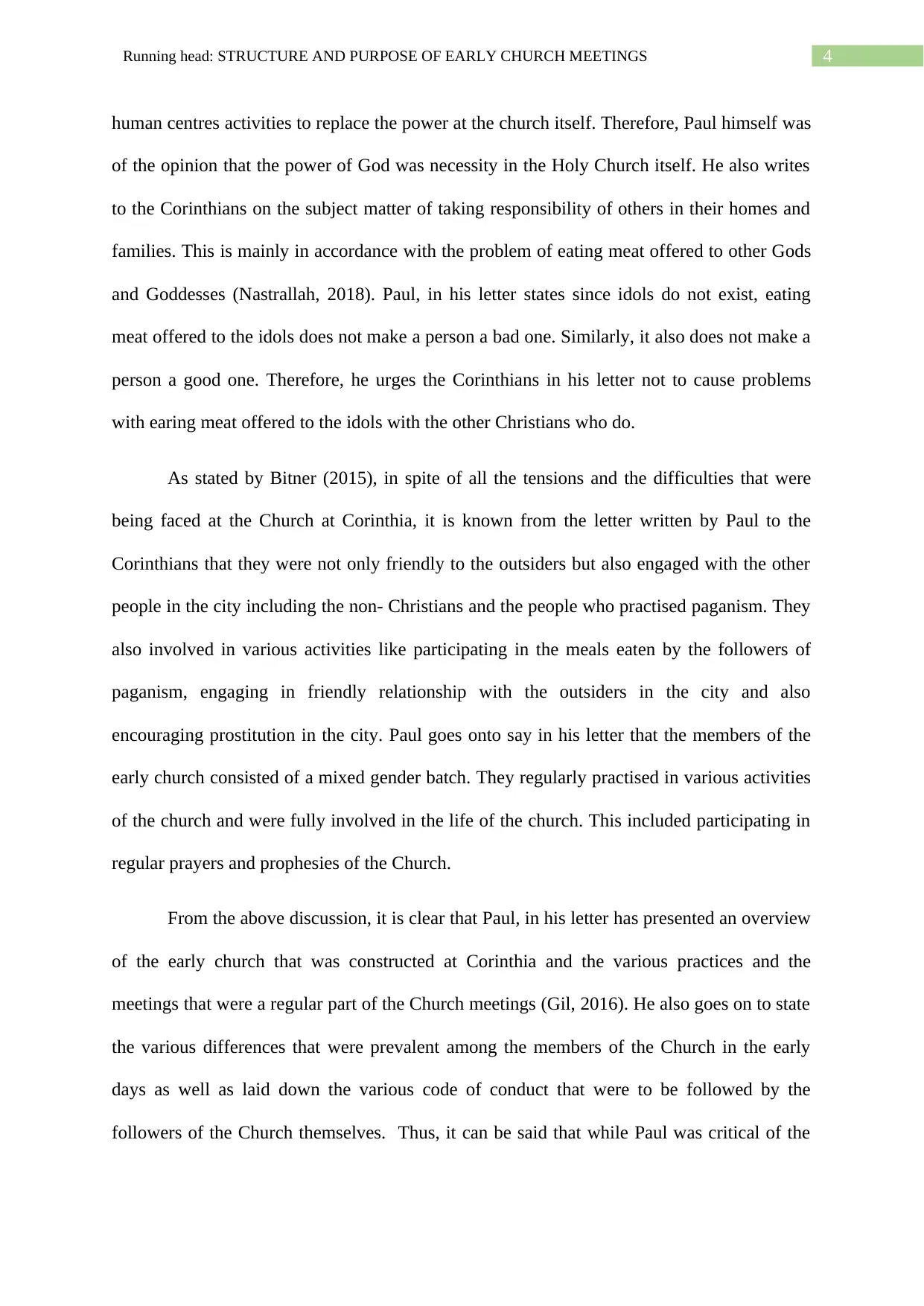
4Running head: STRUCTURE AND PURPOSE OF EARLY CHURCH MEETINGS
human centres activities to replace the power at the church itself. Therefore, Paul himself was
of the opinion that the power of God was necessity in the Holy Church itself. He also writes
to the Corinthians on the subject matter of taking responsibility of others in their homes and
families. This is mainly in accordance with the problem of eating meat offered to other Gods
and Goddesses (Nastrallah, 2018). Paul, in his letter states since idols do not exist, eating
meat offered to the idols does not make a person a bad one. Similarly, it also does not make a
person a good one. Therefore, he urges the Corinthians in his letter not to cause problems
with earing meat offered to the idols with the other Christians who do.
As stated by Bitner (2015), in spite of all the tensions and the difficulties that were
being faced at the Church at Corinthia, it is known from the letter written by Paul to the
Corinthians that they were not only friendly to the outsiders but also engaged with the other
people in the city including the non- Christians and the people who practised paganism. They
also involved in various activities like participating in the meals eaten by the followers of
paganism, engaging in friendly relationship with the outsiders in the city and also
encouraging prostitution in the city. Paul goes onto say in his letter that the members of the
early church consisted of a mixed gender batch. They regularly practised in various activities
of the church and were fully involved in the life of the church. This included participating in
regular prayers and prophesies of the Church.
From the above discussion, it is clear that Paul, in his letter has presented an overview
of the early church that was constructed at Corinthia and the various practices and the
meetings that were a regular part of the Church meetings (Gil, 2016). He also goes on to state
the various differences that were prevalent among the members of the Church in the early
days as well as laid down the various code of conduct that were to be followed by the
followers of the Church themselves. Thus, it can be said that while Paul was critical of the
human centres activities to replace the power at the church itself. Therefore, Paul himself was
of the opinion that the power of God was necessity in the Holy Church itself. He also writes
to the Corinthians on the subject matter of taking responsibility of others in their homes and
families. This is mainly in accordance with the problem of eating meat offered to other Gods
and Goddesses (Nastrallah, 2018). Paul, in his letter states since idols do not exist, eating
meat offered to the idols does not make a person a bad one. Similarly, it also does not make a
person a good one. Therefore, he urges the Corinthians in his letter not to cause problems
with earing meat offered to the idols with the other Christians who do.
As stated by Bitner (2015), in spite of all the tensions and the difficulties that were
being faced at the Church at Corinthia, it is known from the letter written by Paul to the
Corinthians that they were not only friendly to the outsiders but also engaged with the other
people in the city including the non- Christians and the people who practised paganism. They
also involved in various activities like participating in the meals eaten by the followers of
paganism, engaging in friendly relationship with the outsiders in the city and also
encouraging prostitution in the city. Paul goes onto say in his letter that the members of the
early church consisted of a mixed gender batch. They regularly practised in various activities
of the church and were fully involved in the life of the church. This included participating in
regular prayers and prophesies of the Church.
From the above discussion, it is clear that Paul, in his letter has presented an overview
of the early church that was constructed at Corinthia and the various practices and the
meetings that were a regular part of the Church meetings (Gil, 2016). He also goes on to state
the various differences that were prevalent among the members of the Church in the early
days as well as laid down the various code of conduct that were to be followed by the
followers of the Church themselves. Thus, it can be said that while Paul was critical of the
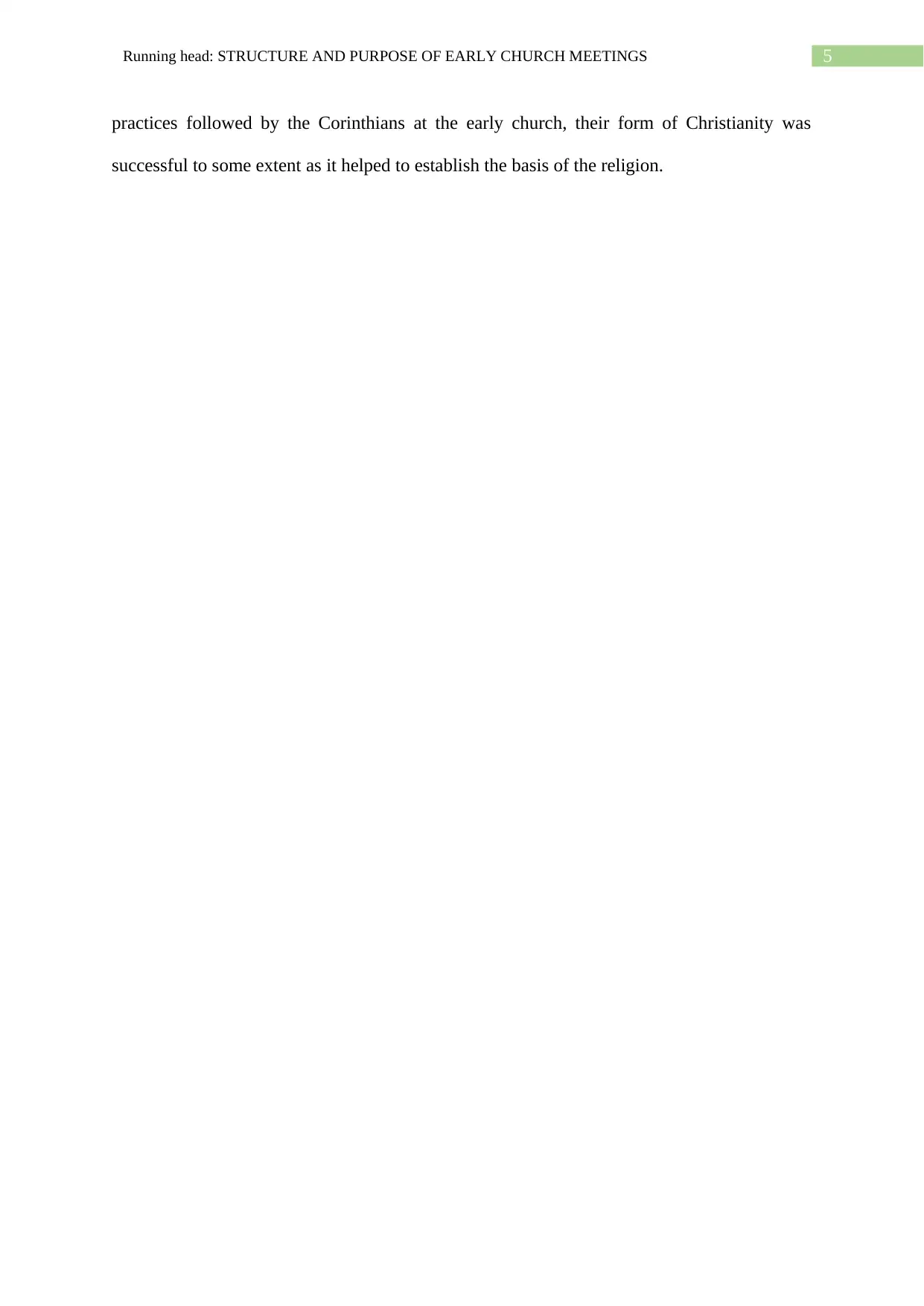
5Running head: STRUCTURE AND PURPOSE OF EARLY CHURCH MEETINGS
practices followed by the Corinthians at the early church, their form of Christianity was
successful to some extent as it helped to establish the basis of the religion.
practices followed by the Corinthians at the early church, their form of Christianity was
successful to some extent as it helped to establish the basis of the religion.
⊘ This is a preview!⊘
Do you want full access?
Subscribe today to unlock all pages.

Trusted by 1+ million students worldwide
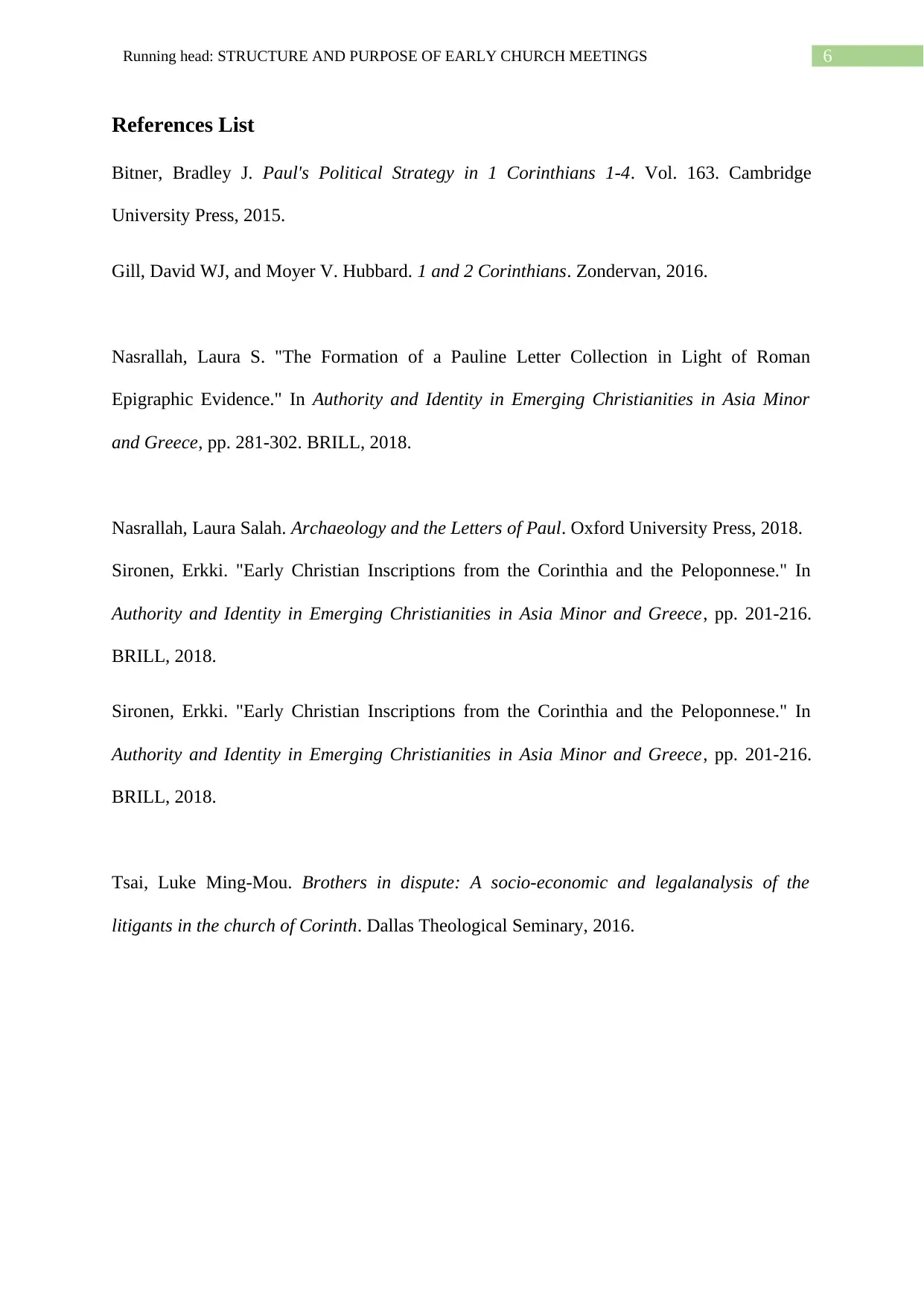
6Running head: STRUCTURE AND PURPOSE OF EARLY CHURCH MEETINGS
References List
Bitner, Bradley J. Paul's Political Strategy in 1 Corinthians 1-4. Vol. 163. Cambridge
University Press, 2015.
Gill, David WJ, and Moyer V. Hubbard. 1 and 2 Corinthians. Zondervan, 2016.
Nasrallah, Laura S. "The Formation of a Pauline Letter Collection in Light of Roman
Epigraphic Evidence." In Authority and Identity in Emerging Christianities in Asia Minor
and Greece, pp. 281-302. BRILL, 2018.
Nasrallah, Laura Salah. Archaeology and the Letters of Paul. Oxford University Press, 2018.
Sironen, Erkki. "Early Christian Inscriptions from the Corinthia and the Peloponnese." In
Authority and Identity in Emerging Christianities in Asia Minor and Greece, pp. 201-216.
BRILL, 2018.
Sironen, Erkki. "Early Christian Inscriptions from the Corinthia and the Peloponnese." In
Authority and Identity in Emerging Christianities in Asia Minor and Greece, pp. 201-216.
BRILL, 2018.
Tsai, Luke Ming-Mou. Brothers in dispute: A socio-economic and legalanalysis of the
litigants in the church of Corinth. Dallas Theological Seminary, 2016.
References List
Bitner, Bradley J. Paul's Political Strategy in 1 Corinthians 1-4. Vol. 163. Cambridge
University Press, 2015.
Gill, David WJ, and Moyer V. Hubbard. 1 and 2 Corinthians. Zondervan, 2016.
Nasrallah, Laura S. "The Formation of a Pauline Letter Collection in Light of Roman
Epigraphic Evidence." In Authority and Identity in Emerging Christianities in Asia Minor
and Greece, pp. 281-302. BRILL, 2018.
Nasrallah, Laura Salah. Archaeology and the Letters of Paul. Oxford University Press, 2018.
Sironen, Erkki. "Early Christian Inscriptions from the Corinthia and the Peloponnese." In
Authority and Identity in Emerging Christianities in Asia Minor and Greece, pp. 201-216.
BRILL, 2018.
Sironen, Erkki. "Early Christian Inscriptions from the Corinthia and the Peloponnese." In
Authority and Identity in Emerging Christianities in Asia Minor and Greece, pp. 201-216.
BRILL, 2018.
Tsai, Luke Ming-Mou. Brothers in dispute: A socio-economic and legalanalysis of the
litigants in the church of Corinth. Dallas Theological Seminary, 2016.
1 out of 7
Related Documents
Your All-in-One AI-Powered Toolkit for Academic Success.
+13062052269
info@desklib.com
Available 24*7 on WhatsApp / Email
![[object Object]](/_next/static/media/star-bottom.7253800d.svg)
Unlock your academic potential
Copyright © 2020–2025 A2Z Services. All Rights Reserved. Developed and managed by ZUCOL.





